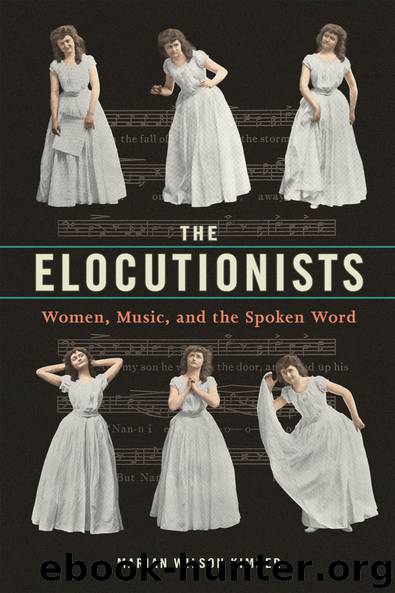The Elocutionists by Wilson Kimber Marian;

Author:Wilson Kimber, Marian; [Неизв.]
Language: eng
Format: epub
Publisher: University of Illinois Press
Published: 2016-12-14T21:00:00+00:00
Figure 7.4. Mary Louise Cassidy-Woelber in Eugene Field’s “Seein’ Things” (1911). Redpath Chautauqua Collection, University of Iowa Libraries, Special Collections.
In the mid-1920s, Clay Smith began to publish the pianologues he composed for his wife Coyla May Spring to perform, providing a glimpse of the circuit’s more formal musical practices.81 His compositions all have vocal lines fully notated with pitches and rhythms; Smith believed that pianologues’ accompaniments should “carry a definite melody throughout as a thread or guide for the words.” He indicated that the piano parts should differ from those for songs:
The harmonies of the accompaniment should furnish suitable background and lend atmosphere to the word picture, giving occasional emphasis to the lines without in any way detracting from them. Since most artists supply their own accompaniments, the piano part should be so written that the hands may be kept rather close together, in order that the performer while turning to the face the audience may still be able to play the accompaniment without any special inconvenience. To [sic] much attention to the key-board might spoil the whole thing.82
In their simple chordal textures and technically unchallenging piano parts, Smith’s compositions are similar to many works by women composers of the same period (discussed in chapter 10), works that he sometimes reviewed for Lyceum magazine. They featured lyrics geared toward Chautauqua audiences: sentimental treatments of home and neighborhood, in keeping with the Chautauquan emphasis on the importance of small-town life, and texts in African American or child dialect. Smith’s chosen texts sometimes advocated traditional gender roles in a way that female composers’ works do not, but would have been in keeping with the values of home and community in the marketing of Chautauqua to rural audiences. “The Old Fashioned Woman” extols the virtues of the “sane, normal,” “housekeeping women, / The motherly women who knew how to cook,” who are no longer found in cities, but are, like Chautauqua audiences, “out in the country.” It is not known if Smith’s own wife, ironically a traveling professional, featured this work in her performances.83
Download
This site does not store any files on its server. We only index and link to content provided by other sites. Please contact the content providers to delete copyright contents if any and email us, we'll remove relevant links or contents immediately.
| Coloring Books for Grown-Ups | Humor |
| Movies | Performing Arts |
| Pop Culture | Puzzles & Games |
| Radio | Sheet Music & Scores |
| Television | Trivia & Fun Facts |
0805097341 (N) by Andrew Dickson(672)
The World Only Spins Forward by Isaac Butler(666)
Chaos Imagined by Martin Meisel(617)
Stella Adler on Ibsen, Strindberg, and Chekhov by Stella Adler(592)
Real Life Drama by Wendy Smith(396)
Philosophy and Theatre by Stern Tom(385)
The Soviet Theater by Laurence Senelick(365)
Poetics of History by Lacoue-Labarthe Philippe;Fort Jeff;(357)
Brecht in Practice by Barnett David(356)
Charles Dickens and the Great Theatre of the World by Simon Callow(352)
The Crucible by Arthur Miller(334)
The Columbia Anthology of Modern Chinese Drama by Xiaomei Chen(320)
Virgil Thomson by Virgil Thomson(300)
Shakespeare and the Countess by Chris Laoutaris(297)
The Definitive Shakespeare Companion by Joseph Rosenblum(286)
The Videofag Book by Jordan Tannahill & Jordan Tannahill(258)
A Short History of English Renaissance Drama by Helen Hackett(238)
A History of Leadville Theater: Opera Houses, Variety Acts and Burlesque Shows by Scanlon Gretchen(232)
Showtime at the Apollo by Ted Fox(230)
